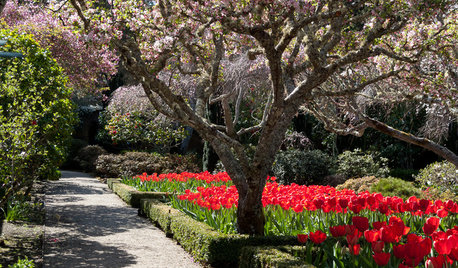Please help a novice with tulips :)
joannemb
14 years ago
Related Stories

PLANTING IDEASEasygoing Tulip Ideas From a Grand California Garden
Gather up these ways to use tulips to make a spring garden of any size overflow with beauty
Full Story
FURNITUREModern Icons: The Saarinen Tulip Dining Table
18 Dining Combinations Featuring the Sleek Pedestal Base
Full Story
SUMMER GARDENINGHouzz Call: Please Show Us Your Summer Garden!
Share pictures of your home and yard this summer — we’d love to feature them in an upcoming story
Full Story
COLORPick-a-Paint Help: How to Create a Whole-House Color Palette
Don't be daunted. With these strategies, building a cohesive palette for your entire home is less difficult than it seems
Full Story
WORKING WITH PROS3 Reasons You Might Want a Designer's Help
See how a designer can turn your decorating and remodeling visions into reality, and how to collaborate best for a positive experience
Full Story
LIFEYou Said It: ‘Put It Back’ If It Won’t Help Your House, and More Wisdom
Highlights from the week include stopping clutter from getting past the door, fall planting ideas and a grandfather’s gift of love
Full Story
LANDSCAPE DESIGN6 Basic Elements of Classic Garden Style
Use symmetry, geometry and other principles of formal design to give even a modest garden a pleasing balance
Full Story
GREENColor Guide: How to Work With Chartreuse
As earthy or electric as you please, this yellow-green hue brings the zing or just freshness to homes from traditional to modern
Full Story
DECORATING GUIDES9 Stylist Tricks for a Decorator Look
You don’t need to be rolling in cash to pull in compliments for polished, eye-pleasing rooms
Full Story
BEDROOMSRoom of the Day: Finding Middle Ground in a Master Bedroom
He loves bold; she loves soft. It took a designer’s intervention to create a space that pleased them both
Full Story



tapla (mid-Michigan, USDA z5b-6a)
oilpainter
Related Discussions
Help please to identify shrubs/plants - Novice Gardener - No. 1.
Q
Help please to identify shrubs/plants - Novice Gardener - No. 2.
Q
Please Help This Calla Lily Novice
Q
Please help need advice - novice with problems
Q
tapla (mid-Michigan, USDA z5b-6a)
joannembOriginal Author
joannembOriginal Author
tapla (mid-Michigan, USDA z5b-6a)
oilpainter
joannembOriginal Author
tapla (mid-Michigan, USDA z5b-6a)
joannembOriginal Author